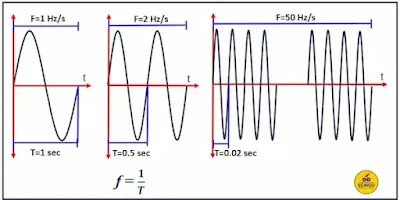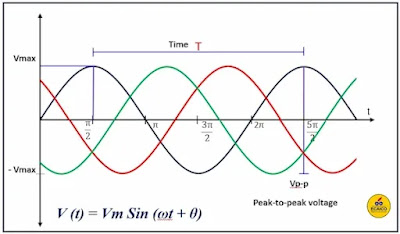Electricity and AC signals
Electricity definition.
Electricity is defined as the electric charge’s movement in conductors, resulting in the generation of electrical energy that can be harvested to be used for various purposes. it is the basic power that plays a vital role in our modern society.Electricity powers everything starting from our homes to the industries and communication and instrumentation systems. it is also used in other applications such as medical technologies, transportation, renewable energy, and agriculture.
Electricity is generated in the power plant through huge power generators through burning conventional fuel sources like oil, coal, and natural gas in boilers. Some other sources could be used in electrical generation such as renewable energy sources (hydropower, solar, and wind. Electricity). It could be transmitted and utilized for human needs.
In this article, we will explain one of the main and wide electricity forms which is the alternative current and voltage (AC). we will define, and list its advantages. we will also explain in brief the main important equations and the main applications in home and industry.
AC reverses its direction periodically where the voltage and current signals oscillate symmetrically around the time axis positively and negatively which makes the average zero. It is represented by sin, square, and triangle waves. It started at zero, increased to the maximum positive value, back to zero, decreased to the maximum negative value, and finally back to zero value then repeated periodically.
AC Alternative current and voltage (AC).
AC Voltage and AC Current denote Alternating voltage and Alternating Current where their values change over time. They are the fundamentals of modern electrical power systems and play an important role in generating, transmitting, and distributing electricity.AC reverses its direction periodically where the voltage and current signals oscillate symmetrically around the time axis positively and negatively which makes the average zero. It is represented by sin, square, and triangle waves. It started at zero, increased to the maximum positive value, back to zero, decreased to the maximum negative value, and finally back to zero value then repeated periodically.
 |
| AC voltage signal |
Advantages of alternating current (AC) over direct current (DC):
Alternating Current (AC) has many advantages over Direct Current (DC) which makes it a good choice for power generation, transmission, and distribution:- By using transformers, AC can be stepped up or stepped down economically and easily.
- Because of the AC step-up and step-down ability, the AC voltage can be raised to high voltage levels for the purpose of long-distance transmission and reduced again to the required voltage needed.
- It is easier to generate AC high-voltage than the generation with Direct Current.
- The AC infrastructure and equipment like transformers and transmission/distribution networks are widely available and can be obtained easily.
- The generation, installation, and maintenance of AC is less expensive than DC.
- The power loss in AC is reduced significantly during transmission compared to DC which is very important when the distance between the power plant and the urban area is very long.
- By using rectifiers, AC can be converted easily to DC.
- AC provides flexibility in applications that require DC and different levels of AC power (like variable speed drives VSDs) by using rectifiers and inverters. This adaptability, combined with the ability to power a wide range of household and industrial devices.
AC voltage equations.
The AC mathematical equations and techniques enable the designers to optimize and analyze the electrical power system effectively and allow the use of several types of devices like induction and synchronous motors efficiently in wide applications.V (t) = Vm Sin (ωt + θ)
Where:
V (t): AC voltage signal (instantaneous value)
ωt: angular frequency
θ: phase angle.
Frequency.
The number of complete cycles per 1-second is called the frequency and is measured by Hertz (Hz). The standard and common two frequencies are 50 or 60 Hz.f = 1 / T
Where:
f: frequency which is the number of cycles per 1 second.
T: time for 1 complete cycle in seconds.
 |
| frequency and signal time |
Angular frequency (Angular velocity)
In AC circuits, Angular frequency is commonly used in physics and engineering to describe how quickly a sine wave oscillates. It is defined as the rate of rotation per second in a periodic motion, it also measures how much radiance per second. Angular frequency is a function of frequency (f) of the AC signal (current or voltage).ω = 2 π f
where:
ω is the angular frequency in radians per second (rad/s),
f is the regular frequency in hertz (Hz),
π (pi) is a mathematical constant approximately equal to 3.14159.
Root mean square value.
Is the effective value of the AC signal that delivers the same power to a certain load delivered by the same DC value. This value is very important because it is used in the direct comparison between the AC and DC values.For the AC voltage equation: V (t) = Vm Sin (ωt + θ).
the RMS value of this signal is:
V(r.m.s) = V max / √2
Where:
V(r.m.s): is the root mean square (effective value) of the AC voltage signal.
Vmax: is the maximum value of the AC voltage signal.
Where:
V(r.m.s): is the root mean square (effective value) of the AC voltage signal.
Vmax: is the maximum value of the AC voltage signal.
Industrial applications of AC Power.
Pumps and compressors are derived by AC power in manufacturing processes as well as, water treatment plants.- AC power can operate air conditions, Large-scale heating, and ventilation for industrial buildings.
- Lighting in industrial warehouses and offices uses AC power.
- Industrial furnaces and ovens in metal forging, ceramic, and glass blowing use AC power.
- Industrial machinery like CNC machines, belt conveyors, and robotics are powered by AC motors.
- Cranes, forklifts, and hoists that are used in material handling operate by AC power.
- Networks and telecommunication industrial settings are powered by AC.
- Many cutting and welding machines use AC power for their operations.
- AC power supports the servers, backup generators, and cooling systems for data centers.
Home applications of AC Power:
- Systems for home automation like smart home devices, cameras, and security systems are powered by AC power.
- AC power can be used to run air conditioning, heaters, and temperature control.
- Many home kitchen devices operate on AC power such as ovens, dishwashers, refrigerators, and microwaves.
- Entertainment devices like home theater, audio, and gaming are powered by AC.
- AC power is used to supply power to office devices like printers, scanners, and computers.
- AC power is used to supply power to various lighting types like LED lights, bulbs, and fluorescent lights.
- Personal Devices like mobile, tablets, and devices working with batteries are using AC power to charge their batteries.













No comments:
Post a Comment